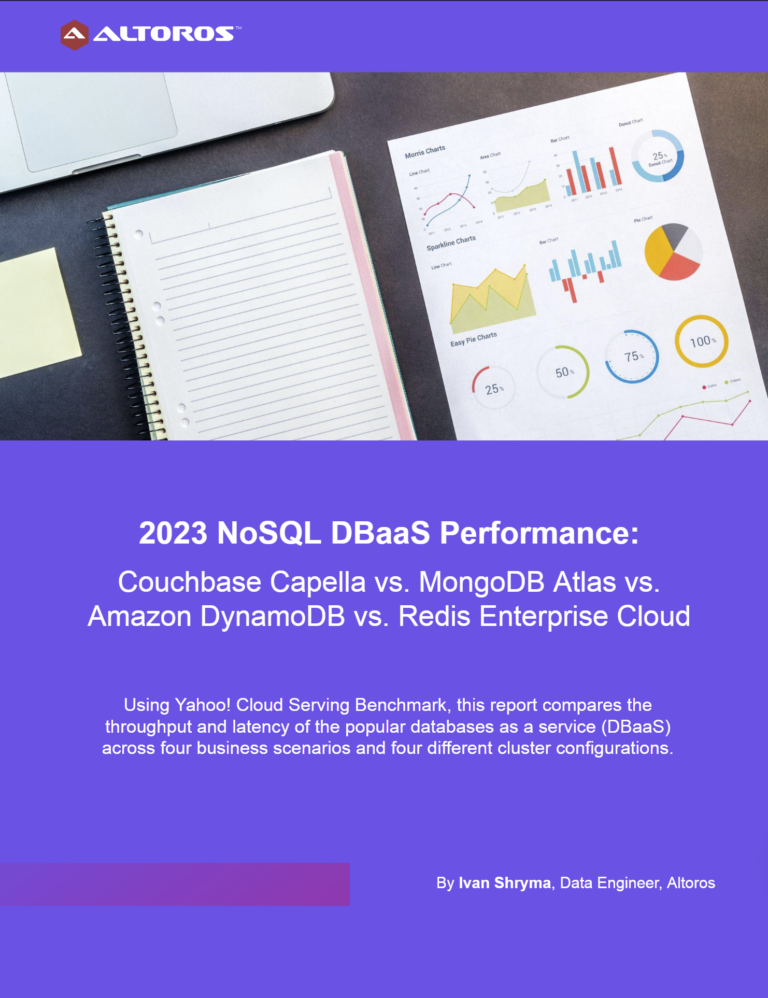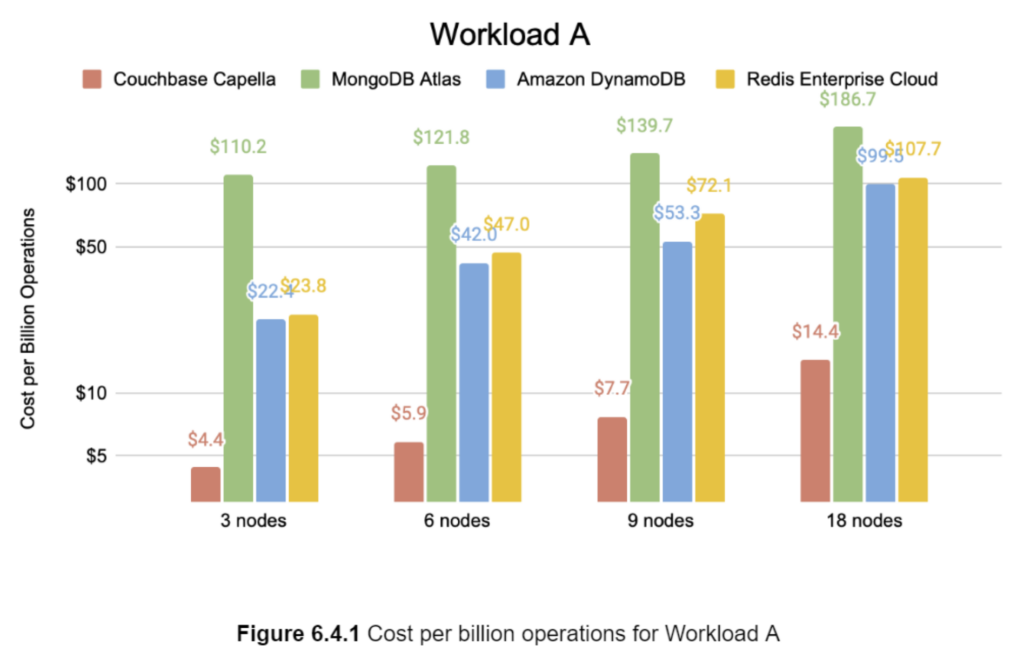 A Altoros, uma renomada organização de consultoria de TI com um extenso histórico de comparação de bancos de dados, publicou seu mais recente benchmark independente, encomendado pela Couchbase. O benchmark avalia as soluções DBaaS oferecidas pela Couchbase, Redis, Amazon e MongoDB. Esse estudo utiliza o padrão YCSB amplamente aceito para avaliar bancos de dados NoSQL. Este blog apresenta um breve resumo do relatório, que demonstra que o Couchbase Capella supera o MongoDB Atlas, o Redis Enterprise Cloud e o Amazon DynamoDB em termos de recursos, desempenho e custo total de propriedade (TCO) em diversas cargas de trabalho e tamanhos de cluster.
A Altoros, uma renomada organização de consultoria de TI com um extenso histórico de comparação de bancos de dados, publicou seu mais recente benchmark independente, encomendado pela Couchbase. O benchmark avalia as soluções DBaaS oferecidas pela Couchbase, Redis, Amazon e MongoDB. Esse estudo utiliza o padrão YCSB amplamente aceito para avaliar bancos de dados NoSQL. Este blog apresenta um breve resumo do relatório, que demonstra que o Couchbase Capella supera o MongoDB Atlas, o Redis Enterprise Cloud e o Amazon DynamoDB em termos de recursos, desempenho e custo total de propriedade (TCO) em diversas cargas de trabalho e tamanhos de cluster.
YCSB (Yahoo! Cloud Serving Benchmark) é uma estrutura padronizada usada para avaliar o desempenho de sistemas de banco de dados baseados em nuvem. Ele consiste em uma variedade de testes de carga de trabalho. Aqui estão as cargas de trabalho escolhidas para este estudo:
-
- Carga de trabalho A, 50% de leitura e 50% de atualização: projetado para simular um cenário de carga de trabalho de gravação pesada em que o sistema de banco de dados lida principalmente com operações de leitura com atualizações ocasionais.
- Carga de trabalho C, 100% read: simula um cenário em que o sistema de banco de dados executa principalmente operações de leitura, fornecendo insights sobre o desempenho e a escalabilidade do sistema especificamente para cargas de trabalho com uso intensivo de leitura.
- Carga de trabalho de paginaçãoA carga de trabalho de banco de dados de dados de dados é a seguinte: emula um cenário que envolve a recuperação de dados paginados. Nessa carga de trabalho, o sistema de banco de dados é avaliado com base em sua capacidade de buscar com eficiência um subconjunto de dados de um conjunto de dados maior, normalmente por meio de uma combinação de operações de leitura e busca. Isso ajuda a avaliar o desempenho do sistema no tratamento de operações de paginação e recuperação de dados comumente encontradas em aplicativos que exigem a exibição de dados em partes menores, como um quadro de líderes ou a implementação de mecanismos de paginação para longas séries de resultados ordenados.
- Carga de trabalho E, 95% leitura, 5% atualização: projetado para avaliar o desempenho e a escalabilidade de um sistema de banco de dados em uma carga de trabalho em que a maioria das operações são leituras, com uma proporção menor de atualizações.
Destaques do Benchmark
Para obter os resultados, não deixe de conferir o relatório detalhado da Altoros. Observe que o novo mecanismo de armazenamento Magma foi usado para esse conjunto de benchmarks. (O Magma tem benefícios de eficiência e requisitos de memória reduzidos para armazenamento de dados grandes, mas para velocidade pura Loja de sofás geralmente será a melhor opção). Aqui estão alguns destaques.
Desempenho
Como nos anos anteriores, o Couchbase se sai extraordinariamente bem em um caso de uso com muitas atualizações, especialmente quando a necessidade de grande escala aumenta. Por exemplo, aqui estão os resultados da Carga de Trabalho A:
Nesses gráficos, você pode ver que a taxa de transferência do Capella é a mais alta de todas as quatro ofertas de DBaaS. Devido à arquitetura memory-first da Capella e à fragmentação automática, a latência também é a mais baixa entre os quatro concorrentes.
Funcionalidade
Vale a pena destacar a carga de trabalho C para um caso de uso de "cache puro". O Capella e o Redis Enterprise Cloud têm um bom desempenho para essa carga de trabalho devido a seus projetos que priorizam a memória, que podem armazenar em cache os resultados para uma resposta mais rápida. O MongoDB e o DynamoDB precisam ler os dados do disco com mais frequência e, portanto, não têm um desempenho tão bom. Vimos muitos projetos em que o MongoDB é ampliado com um sistema semelhante ao Redis para atuar como cache, enquanto o Couchbase tem esse recurso incorporado.
Mais uma vez, alta taxa de transferência e baixa latência.
No entanto, embora o Redis tenha um desempenho muito bom no caso de um cache puro, ele tem dificuldades com outra carga de trabalho: paginação.
Como nos anos anteriores, o DynamoDB foi deixado de fora dessa carga de trabalho, pois não tem nenhum recurso de paginação em sua linguagem de consulta. O Redis tem recursos de paginação, mas seu desempenho é muito ruim. Em uma implantação típica do Redis, esse tipo de processamento seria transferido para um banco de dados secundário. O Capella lida muito bem com essa carga de trabalho: alta taxa de transferência, baixa latência e sintaxe SQL fácil de SELECT . . . LIMIT . . . OFFSET.
Por outro lado, o DynamoDB tem um bom desempenho na Carga de Trabalho E. No entanto, há alguns outros fatores a serem considerados com a Carga de Trabalho E no Dynamo: veja mais detalhes no relatório sobre como o DynamoDB foi provisionado, o dinheiro necessário e o comportamento do DynamoDB com relação à limitação e ao aumento de escala.
Custo total de propriedade (TCO)
No caso de um "cache puro", o Redis é frequentemente usado em conjunto com outros bancos de dados. Você obterá um bom desempenho do cache, mas ao preço de executar dois bancos de dados separados. (Por exemplo, Redis e Mongo, Redis e Oracle, etc.).
Com relação à "rentabilidade", há gráficos incluídos que resumem o custo de cada implantação de banco de dados em "dólares por bilhão de operações". Por exemplo, aqui está o gráfico da carga de trabalho A (barras mais curtas significam menos caro):
Ao ler o relatório completo em detalhes, você verá que o Couchbase nem sempre vence todos os confrontos. No entanto, o que ele ganha é o quadro geral: uma combinação ideal de baixo custo, funcionalidade sofisticada e desempenho (a "ameaça tripla", como afirmou nosso cliente Broadjump).
O Couchbase Capella se sai muito bem na maioria das combinações de carga de trabalho + cluster. Além disso, o Capella é um banco de dados multimodelo rápido e extremamente versátil que inclui:
-
- Valor-chave - pesquisa direta em velocidades de memória
- Armazenamento em cache incorporado - baixa latência, pesquisa rápida
- Documento JSON - dados flexíveis
- SQL++ - consulta flexível
- Pesquisa de texto completo - pesquisas de texto, classificação e geoespaciais (sem a necessidade de uma ferramenta separada, como o Solr)
- Séries temporais - armazenados em TS_arrays em JSON com funções de formatação incorporadas
- Sincronização móvel - automático e off-line primeiro com sincronização de cliente para cliente, também!
- Sharding/particionamento automático - fácil para os desenvolvedores e excelente para o crescimento
- Replicação e rebalanceamento automáticos - fácil para as operações
- Análise com SQL++ - opções de consulta complexas para BI
- Eventos - lógica de processamento no nível do banco de dados
- Captura de dados de alterações com o Kafka integração para transmitir registros de alterações de documentos
Levando em consideração todos esses fatores, o Couchbase Capella oferece o melhor pacote total de alto desempenho, funcionalidade sofisticada e menor custo total de propriedade.
Próximas etapas
-
- Certifique-se de ler o relatório final da Altoros
- Inscreva-se para uma avaliação gratuita do Couchbase Capella
- Tem dúvidas? Dê uma olhada na seção Discórdia do Couchbase



